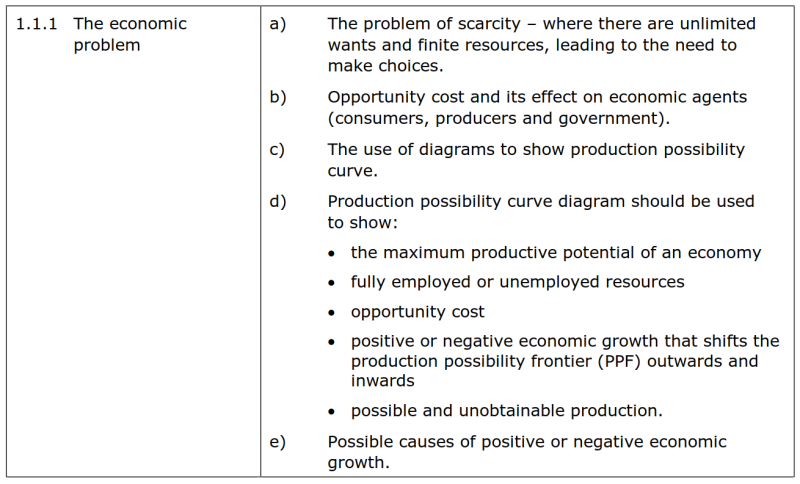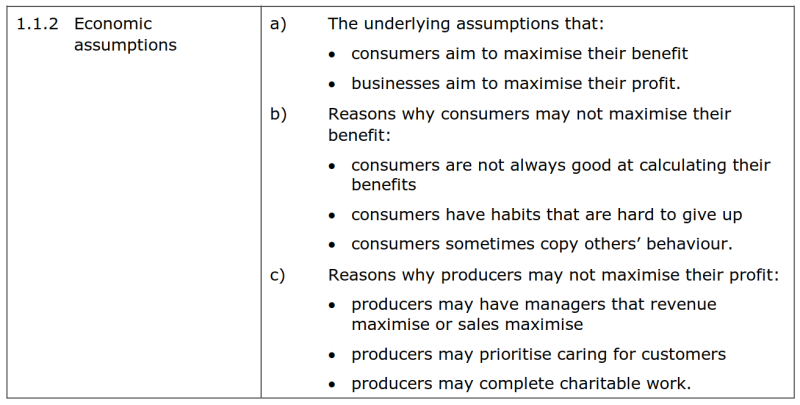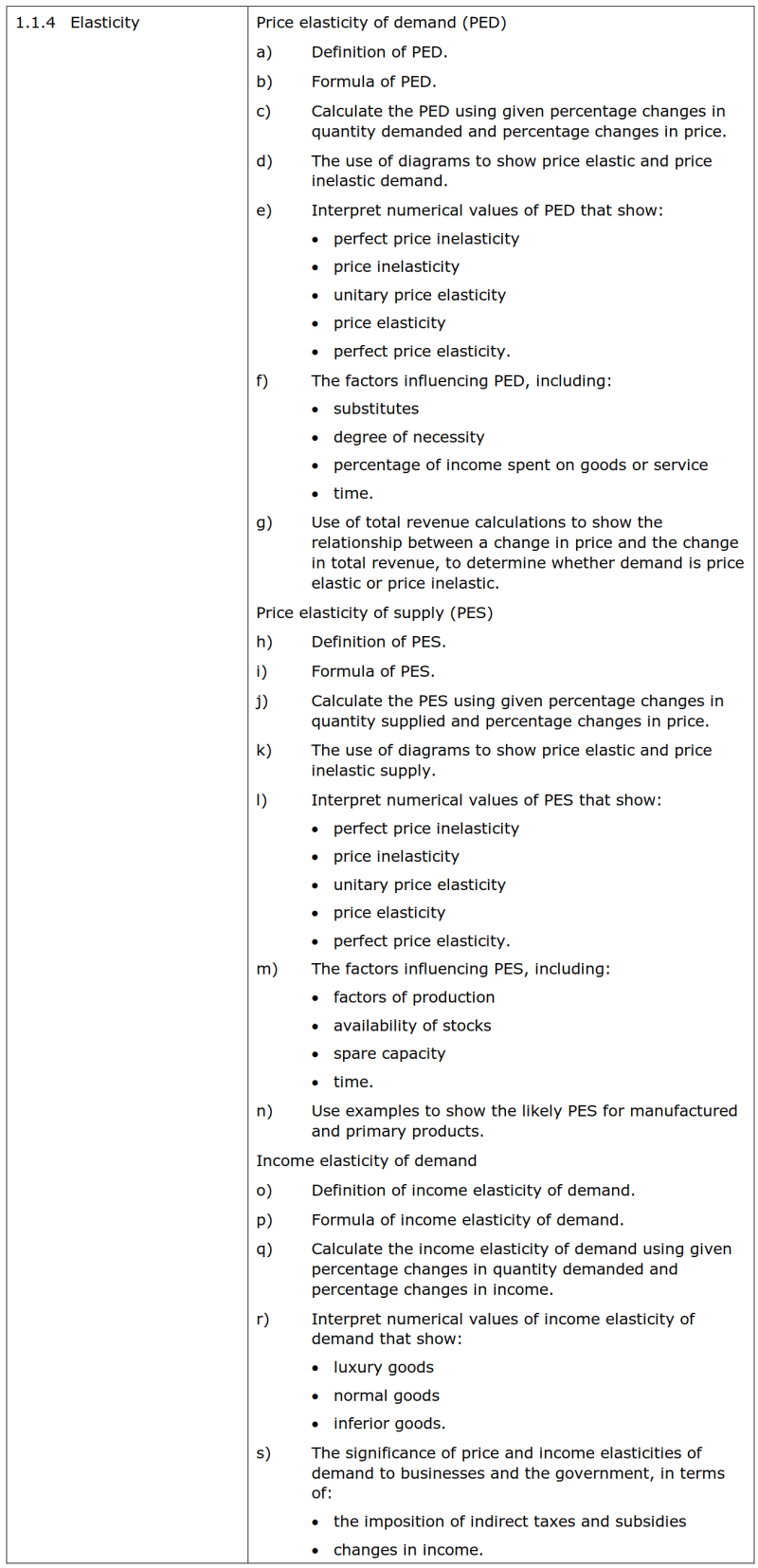“Edexcel IG revision - 1.1 (2019)”的版本间的差异
| 第267行: | 第267行: | ||
*Demand curve与supply curve线移动shift的原因可【参考1.1.3(c)和1.1.3(f)】。 | *Demand curve与supply curve线移动shift的原因可【参考1.1.3(c)和1.1.3(f)】。 | ||
*Demand curve与supply curve线移动shift后,均衡点发生变化,相应的equilibrium price和equilibrium quantity也会跟着发生变动。(如下图所示) | *Demand curve与supply curve线移动shift后,均衡点发生变化,相应的equilibrium price和equilibrium quantity也会跟着发生变动。(如下图所示) | ||
<center> [[File: CAIE2023-2.4.2-1.png | | <center> [[File: CAIE2023-2.4.2-1.png |500px]] </center> | ||
<br/> | <br/> | ||
**注意:考试时画完图像后,需要对图像进行解释和描述。文字部分主要围绕shift线移动的原因、移动方向、均衡价格和均衡数量的变化情况来进行描述。 | **注意:考试时画完图像后,需要对图像进行解释和描述。文字部分主要围绕shift线移动的原因、移动方向、均衡价格和均衡数量的变化情况来进行描述。 | ||
| 第276行: | 第276行: | ||
***如果市场正常运转,价格将上涨到均衡价格,此时quantity supplied增加,quantity demanded减少,因此shortage消失。 | ***如果市场正常运转,价格将上涨到均衡价格,此时quantity supplied增加,quantity demanded减少,因此shortage消失。 | ||
***Excess demand常见图像: | ***Excess demand常见图像: | ||
<center> [[File: CAIE2023-2.4.1-2.png | | <center> [[File: CAIE2023-2.4.1-2.png |450px]] </center> | ||
<br/> | <br/> | ||
**Excess supply:超额供给(价格偏高)。在当前价格下,供给高于需求。 | **Excess supply:超额供给(价格偏高)。在当前价格下,供给高于需求。 | ||
| 第282行: | 第282行: | ||
***如果市场正常运转,价格将下跌到均衡价格,此时quantity supplied减少,quantity demanded增加,因此surplus消失。 | ***如果市场正常运转,价格将下跌到均衡价格,此时quantity supplied减少,quantity demanded增加,因此surplus消失。 | ||
***Excess supply常见图像: | ***Excess supply常见图像: | ||
<center> [[File: CAIE2023-2.4.1-3.png | | <center> [[File: CAIE2023-2.4.1-3.png |450px]] </center> | ||
<br/> | <br/> | ||
2023年7月11日 (二) 00:29的版本
如遇到公式加载异常,请刷新页面!
1.1 The market system 市场机制
1.1.1 The economic problem 经济问题
- 大纲要求
a) The problem of scarcity – where there are unlimited wants and finite resources, leading to the need to make choices. 稀缺性问题 – 无限愿望与有限资源导致人们需要做出选择
- Scarcity:稀缺性。resources资源在人们unlimited wants无限的愿望面前永远都是稀缺的,这是资源的固有属性(仅有很少的资源可以认为是不稀缺的)。
- Basic economic problem:基本经济问题,也称作fundamental economic problem或problem of scarcity,指finite resources有限的资源与人们unlimited wants无限的愿望之间的矛盾。
- 注意:needs是满足人们基本生活的需求,是有限的;而wants是提高人们生活质量的需求,是无限的。
- 由于资源具有稀缺性,稀缺的资源难以满足人们无限的愿望,因此人们需要在众多愿望中做出choices选择。
b) Opportunity cost and its effect on economic agents (consumers, producers and government). 机会成本与其对经济主体的影响
- Opportunity cost:机会成本,指的是对所有可能的choices进行排序,在选择了一个最优选择后,放弃掉的次优选择(next best alternative)的价值。
- 比如鱼和熊掌不可兼得,如果选择鱼,则熊掌的价值就是选择鱼的机会成本。
- Economic agents:经济主体,即经济中的各个群体,一般可分为consumer消费者、producer生产者和government政府,有时还可以进一步细分出worker工人、supplier供应商等。
- 对于consumer消费者来说,选择某样商品购买时,会放弃购买一些其他商品,这些放弃掉的产品的价值即为机会成本。
- 对于producer生产者来说,选择某样商品生产时,会放弃生产一些其他商品,这些放弃掉的产品的价值即为机会成本。
- 对于government政府来说,选择某个发展方向时(如改善教育),会放弃一些其他发展方向(如改善医疗),这些放弃掉的发展情况的价值即为机会成本。
c) The use of diagrams to show production possibility curve. 使用图像展示生产可能性曲线
- production possibility curve生产可能性曲线(PPC):指一个经济体用尽当前全部资源all of the current resources,能够生产出来的最大产出(maximum output)。
- 别称:production possibility frontier(PPF)生产可能性边界。
- 生产可能性曲线的常见图像
- 注意:两坐标轴名称通常为两种商品,如果没有指定商品,可用capital goods资本品和consumer goods消费品,或者Good A和Good B。
- 线上的每一点代表着如果用尽当前资源可生产的两种产品的组合情况combinations。如下图A点代表用尽当前资源可生产700辆车和1200台电视,B点代表用尽当前资源可生产500辆车和1500台电视。
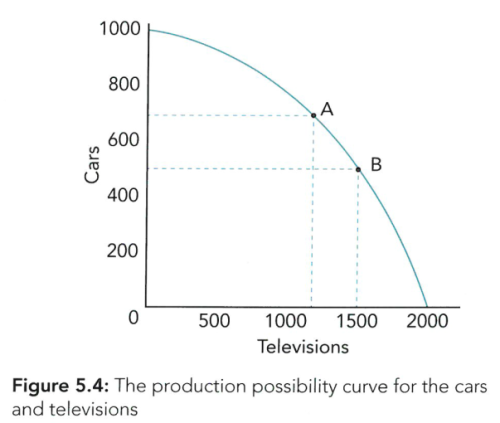
d) Production possibility curve diagram should be used to show: 生产可能性曲线用于展示以下内容
• the maximum productive potential of an economy
• fully employed or unemployed resources
• opportunity cost
• positive or negative economic growth that shifts the production possibility frontier (PPF) outwards and inwards
• possible and unobtainable production.
- PPC线内、线上、线外各点的经济含义
- 线内(C):低于最大产出below maximum output、生产无效率productive inefficiency。
- 线上(A、B):最大产出maximum output、生产效率productive efficiency。(所有点都满足,无论位置)
- 线外(D):当前生产水平达不到该产出,资源稀缺scarcity。(注意是当前达不到,而不是永远达不到。随着PPC外扩,未来可能会达到该点。)
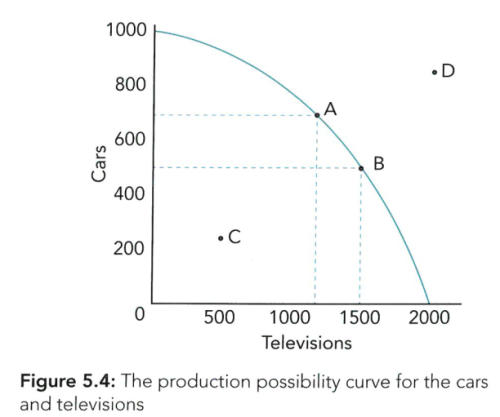
- PPC与opportunity cost
- PPC中的opportunity cost表现为随着A产品产量增加,B产品产量下降。B产品下降损失的价值即为增加A产品生产的机会成本。
- 随着A产品上升,opportunity cost保持不变constant的时候,PPC呈一条直线。
- 这是由于生产要素在两种商品间没有偏向性be equally suited,被平等地消耗。
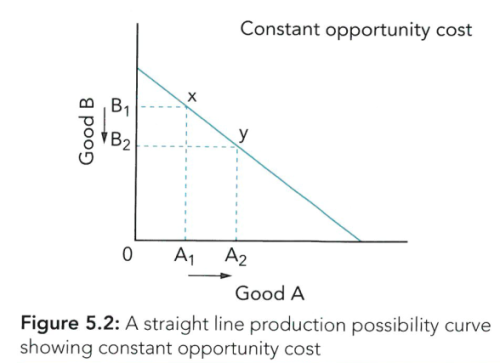
- 随着A产品上升,opportunity cost持续上升increasing的时候,PPC呈一条拱形convex to the origin/be curved outwards的曲线。
- 这是因为生产要素对两种商品的生产有偏向性,随着A商品产量增加,适合B生产的生产要素不断被夺走,造成B商品损失的收益越来越多。
- 随着A产品上升,opportunity cost持续上升increasing的时候,PPC呈一条拱形convex to the origin/be curved outwards的曲线。
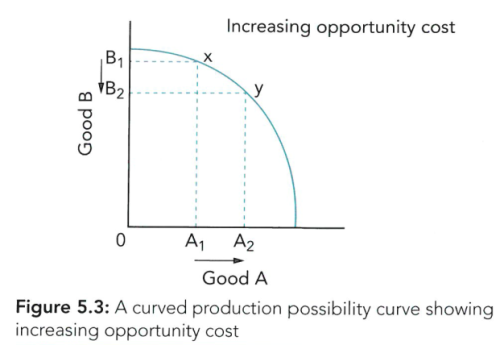
- PPC上的点移movement
- 原因:资源在两种商品间的再分配a trade-off between products。下图中从A到B的移动表示资源从A转移了一部分到B,从而少了一些车,多了一些电视。
- 点移动后的数量上升为expansion,下降为contraction。
- PPC发生旋转移动pivot
- 单商品pivot移动原因:仅生产该商品的某些生产要素发生变动。如下图PPC1旋转变动到PPC2,可能是电视的生产技术进步、制造电视的工人增加、电视原材料供应增加等。
- 旋转移动的方向:pivot inwards向内(数量下降)/outwards向外(数量上升)。
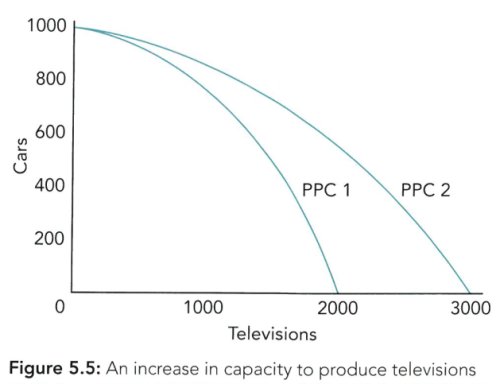
- PPC发生整体线移shift
- 线整体外移shift outwards/rightwards原因:经济增长,包括生产要素数量增加和质量提升。
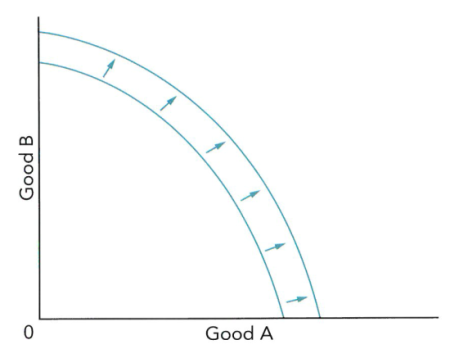
- 线整体内移shift inwards/leftwards原因:经济衰退(主要是长期衰退。短期衰退可表现为点移到PPC内部)
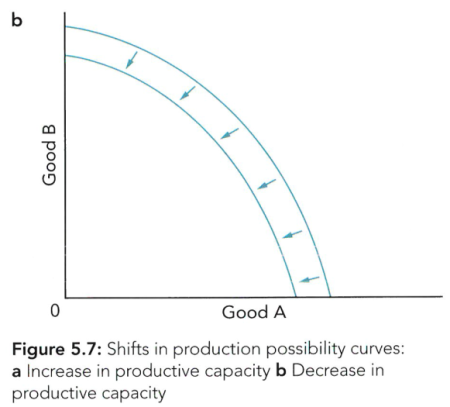
e) Possible causes of positive or negative economic growth. 经济正增长与负增长的可能原因
- Positive economic growth经济正增长的原因可能包括:
- 生产要素数量的增加:如填海造陆、发现新矿藏、向国内移民等。
- 生产要素质量的提升:如技术进步、生产效率上升、教育进步等。
- Negative economic growth经济负增长的原因可能包括:
- 生产要素数量的减少:如矿藏资源枯竭、向国外移民等。
- 生产要素质量的下降:如生产效率下降、技术退步等。
1.1.2 Economic assumptions 经济假设
- 大纲要求
a) The underlying assumptions that: 基本假设
• consumers aim to maximise their benefit
• businesses aim to maximise their profit.
- Rationality:理性,指人们仅按照产品或资源对自己的利益提升情况来做出决定。
- hypothesis of rational man理性人假设是经济学的基本假设。
- 对于consumer消费者而言,理性表现在utility maximisation效用最大化。
- 对于producer生产者而言,理性表现在profit maximisation利润最大化。
b) Reasons why consumers may not maximise their benefit: 消费者不能最大化其利益的原因
• consumers are not always good at calculating their benefits
• consumers have habits that are hard to give up
• consumers sometimes copy others’ behaviour.
- 消费者不理性(未最大化利益)的原因:
- 不擅长计算。
- 习惯性行为。
- 跟风(herding behaviour羊群效应)。
- inertia惰性。
- feel valued感到被他人重视。
- 无需当即付款(如使用信用卡)。
- 优惠券。
c) Reasons why producers may not maximise their profit: 生产者不能最大化其利益的原因
• producers may have managers that revenue maximise or sales maximise
• producers may prioritise caring for customers
• producers may complete charitable work.
- 生产者不理性(未最大化利益)的原因:
- 经理人追求其他目标(如收入最大化、销量最大化等)。
- 生产者优先考虑消费者的情况(如低价促销等)。
- 生产者做慈善(一般为提升企业形象和reputation声望)。
1.1.3 Demand, supply and market equilibrium 需求、供给和市场均衡
- 大纲要求
1.1.3.1 Demand
a) Definition of demand. 需求的定义
- Demand:需求,指对于每个给定的价格,消费者consumers有意愿willing并且有能力able购买的产品数量。
- 注意:经济学研究的需求理论基于effective demand有效需求,即现实中能够实现的需求。
- 注意:Quantity demanded表示需求量,是数量。Demand表示的是价格与需求量的关系,是函数关系。
b) The use of demand curve diagram to show: 使用需求曲线展示
• changes in price causing movements along a demand curve
• shifts indicating increased and decreased demand.
- Demand curve表示的是price价格与quantity demanded需求量之间呈反比的关系。
- 普通的demand curve如下图所示:(横轴是quantity,纵轴是price,题目中没要求数字的时候可以画成没有数据的示意图。)

- Movement点移动
- Demand curve发生movement点移动的唯一原因是本商品的price发生了变化。Price上升会导致quantity demanded下降,反之同理。
- Movement点移动时,量的增加称为extension,量的下降称为contraction。
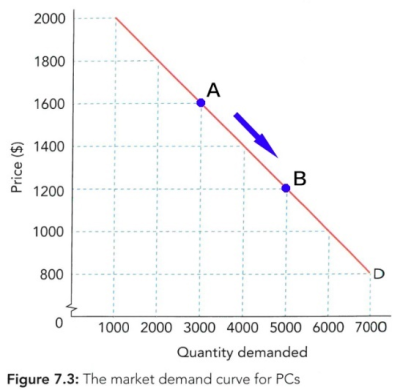
- Shift线移动
- 除了price因素之外的其他影响因素(即Non-price factors非价格因素)都会导致Demand curve发生shift型移动。【影响因素参考1.1.3(c)】
- Demand curve左移shift leftwards表示需求下降(左图所示),右移shift rightwards表示需求上升(右图所示)。
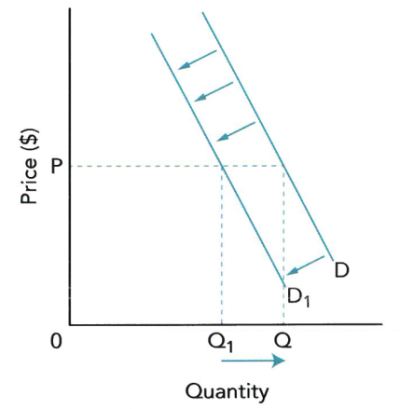

c) Factors that may cause a shift in the demand curve, including: 使得需求线发动线移动的因素
• advertising
• income
• fashion and tastes
• price of substitute goods
• price of complementary goods
• demographic changes.
- Disposable income可支配收入。
- 如果属于Normal goods通常商品,收入越高,需求越高。绝大多数商品属于该种情况。
- 如果属于inferior goods劣质商品,收入越高,需求越低。
- Inferior goods的例子包括:poor quality foodstuffs、used clothing、low-grade rice and vegetables…
- Price and availability of related products其他商品价格。
- 如果属于substitutes替代品(二者功能近似,满足消费者同样的需求,如可口可乐和百事可乐),A商品价格越高,B商品的需求越高。(图像如下)
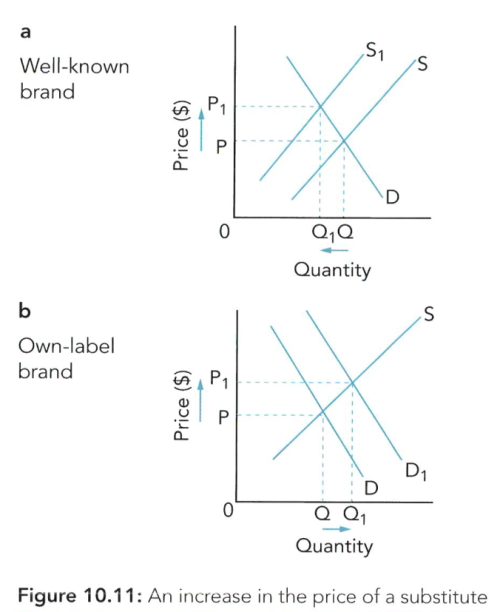
- 如果属于complements互补品(二者组合起来能满足消费者的需求,如笔记本和鼠标),A商品价格越高,B商品的需求越低。(图像如下)
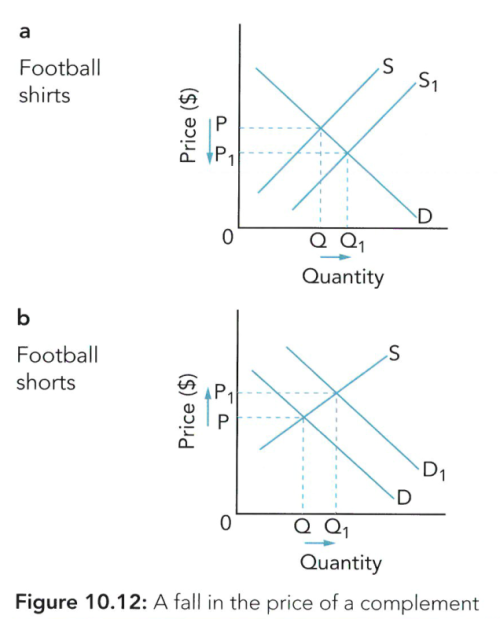
- Advertisement广告、marketing市场营销
- 广告越多、市场营销越好,需求越高。
- fashion时尚
- 商品越时尚流行,需求越高。
- habit习惯、taste口味、attitude态度
- 商品越符合人们的习惯和口味,需求越高。
- 人们对商品的态度影响对商品的需求,如支持该商品则增加需求,抵制该商品则减少需求。
- population人口(demographic change)
- 人口越多,需求越高。
1.1.3.2 Supply
d) Definition of supply. 供给的定义
- Supply:供给,指对于每个给定的价格,生产者producers有意愿willing并且有能力able生产并提供的产品数量。
- 注意:Quantity supplied表示供给量,是数量。Supply表示的是价格与供给量的关系,是函数关系。
e) The use of supply curve diagram to show: 使用供给曲线展示
• changes in price causing movements along a supply curve
• shifts indicating increased and decreased supply.
- Supply curve表示的是price价格与quantity supplied供给量之间呈正比的关系。
- 普通的supply curve如下图所示:(横轴是quantity,纵轴是price,题目中没要求数字的时候可以画成没有数据的示意图。)

- Movement点移动
- Supply curve发生movement点移动的唯一原因是本商品的price发生了变化。Price上升会导致quantity supplied上升,反之同理。
- Movement点移动时,量的增加称为extension,量的下降称为contraction。

- Shift线移动
- 除了price因素之外的其他影响因素(即Non-price factors非价格因素)都会导致Supply curve发生shift型移动。【参考1.1.3(f)】
- Supply curve左移shift leftwards表示供给下降(左图所示),右移shift rightwards表示供给上升(右图所示)。
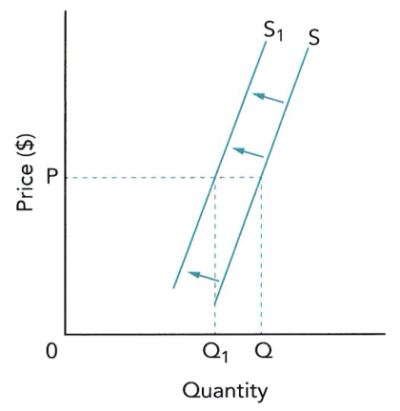

f) Factors that may cause a shift in the supply curve, including: 使得供给线发动线移动的因素
• costs of production
• changes in technology
• indirect taxes
• subsidies
• natural factors (natural disasters and weather).
- Costs成本。
- 成本包括原材料成本(price of raw materials),能源成本(price of oil等),人力成本(wage等),维护成本(maintenance costs),分销成本(distribution costs)。成本越高,供给越少。
- Productivity生产率。
- 生产率越高,供给越多。
- Government policy政府政策。
- Taxation税收越多,供给越少。
- Subsidy补贴越高,供给越多。
- 政府政策越松(relaxation of certain types of legislation),供给越多。
- Technology技术。
- 技术水平越高,供给越多。
- Weather conditions天气情况。
- (一般和农业相关)天气或气候越好,供给越多。反之,天气或气候越差,供给越少。
1.1.3.3 Market equilibrium
g) Equilibrium price and quantity and how they are determined. 均衡价格和数量及它们如何确定
- 市场均衡market equilibrium:市场需求与市场供给相等,如果没有外部影响,价格将长期停留在该水平,没有再变化的倾向no tendency to change。
- 市场均衡时的价格叫equilibrium price,需求量/供给量叫equilibrium quantity。此时,称为市场出清market clears。
- market equilibrium常见图像:
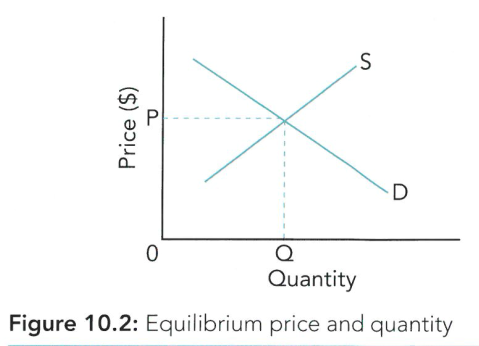
h) The use of diagrams to show: 使用图像展示
• how shifts in supply and demand affect equilibrium price and quantity in real-world situations
• excess demand
• excess supply.
- Demand curve与supply curve线移动shift的原因可【参考1.1.3(c)和1.1.3(f)】。
- Demand curve与supply curve线移动shift后,均衡点发生变化,相应的equilibrium price和equilibrium quantity也会跟着发生变动。(如下图所示)
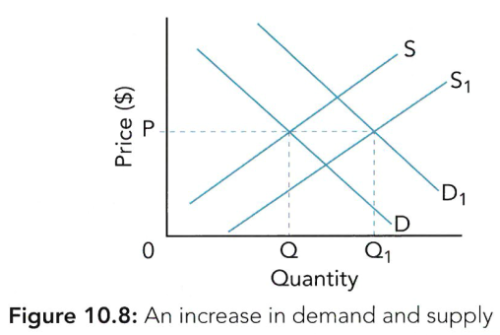
- 注意:考试时画完图像后,需要对图像进行解释和描述。文字部分主要围绕shift线移动的原因、移动方向、均衡价格和均衡数量的变化情况来进行描述。
- 市场失衡market disequilibrium:市场需求与市场供给不相等。主要分两种情况。
- Excess demand:超额需求(价格偏低)。在当前价格下,需求高于供给。
- 出现shortage短缺(P1价格时,图中shortage部分为Q2Q1的长度)。
- 如果市场正常运转,价格将上涨到均衡价格,此时quantity supplied增加,quantity demanded减少,因此shortage消失。
- Excess demand常见图像:
- Excess demand:超额需求(价格偏低)。在当前价格下,需求高于供给。

- Excess supply:超额供给(价格偏高)。在当前价格下,供给高于需求。
- 出现surplus盈余(P1价格时,图中surplus部分为Q1Q2的长度)。
- 如果市场正常运转,价格将下跌到均衡价格,此时quantity supplied减少,quantity demanded增加,因此surplus消失。
- Excess supply常见图像:
- Excess supply:超额供给(价格偏高)。在当前价格下,供给高于需求。
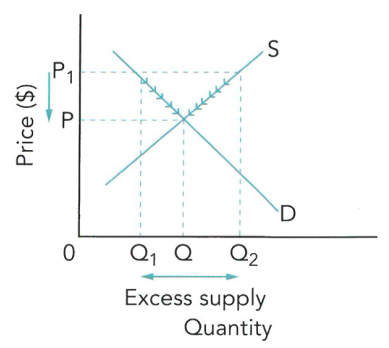
- 注意(评价):完全交给市场调节,可能有以下问题:
- Time lags:时滞。市场调节需要一定时间,无法一步调节到位。比如,Influenced by how long it takes consumers and producers to make known the price. 消费者和生产者得知价格不在均衡位置上需要一段时间。
- Stay in disequilibrium for a long time due to geographical or other problems.因为种种原因长期滞留于不均衡位置。如交通障碍、国界、天气原因等。
i) Define, calculate and draw excess demand and excess supply. 定义、计算和画出超额需求和超额供给
- 【参考1.1.3(h)】。
j) The use of market forces to remove excess supply or excess demand. 使用市场力移除超额需求和超额供给
- 【参考1.1.3(h)】。
1.1.4 Elasticity 弹性
- 大纲要求
1.1.4.1 Price elasticity of demand (PED) 需求的价格弹性
a) Definition of PED. PED的定义
- Price elasticity of demand(PED):需求的价格弹性,指当价格发生一定程度的变化时,需求量对价格变化的反应程度responsiveness。
- 注意:所谓反应程度responsiveness,可以理解为需求量的变化幅度。影响因素变动幅度相同时,需求量变化幅度越大,弹性越大。
b) Formula of PED. PED的公式
- \(PED=\frac{percentage\space change\space in\space quantity\space demanded}{percentage\space change\space in\space price}=\frac{\displaystyle{\%}\Delta Q}{\displaystyle{\%}\Delta P}\), 其中\(\displaystyle{\%}\Delta Q=\frac{Q_{2}-Q_{1}}{Q_{1}}\), \(\displaystyle{\%}\Delta P=\frac{P_{2}-P_{1}}{P_{1}}\)
- 注意:PED一般是负数,因为价格和需求量的变化方向相反。
c) Calculate the PED using given percentage changes in quantity demanded and percentage changes in price. 计算PED
- 【参考1.1.4(b)】。
d) The use of diagrams to show price elastic and price inelastic demand. 使用图像展示价格有弹性的需求和价格缺乏弹性的需求
- 【参考1.1.4(e)】。
e) Interpret numerical values of PED that show: 解释PED的数值
• perfect price inelasticity
• price inelasticity
• unitary price elasticity
• price elasticity
• perfect price elasticity.
- PED各弹性分类情况如下表所示(PED value已经忽略符号,图像为整条Demand curve中的很小一段的截图)
| Elasticity description | Value | PED Diagram |
|---|---|---|
| perfectly elastic 完全弹性 |
∞ infinity |
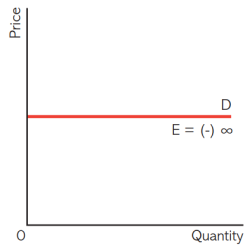
|
| (highly) elastic 富有弹性 |
>1 | 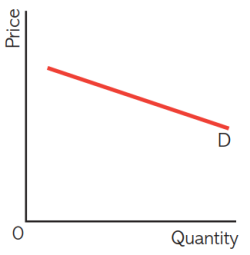
|
| unit elasticity (始终保持1的)单位弹性 |
1 | 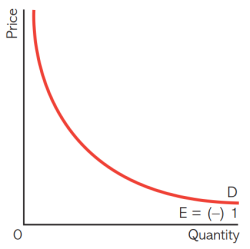
|
| (highly) inelastic 缺乏弹性 |
0~1 | 
|
| perfectly inelastic 完全无弹性 |
0 | 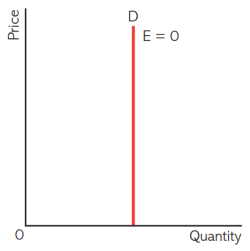
|
f) The factors influencing PED, including: 影响PED的因素
• substitutes
• degree of necessity
• percentage of income spent on goods or service
• time.
- Availability and attractiveness of (consumption) substitutes消费替代品的可获得性及吸引力
- 替代品种类越多,PED越大。
- 替代品功能越相近,PED越大。
- 商品概念越宽泛,PED越小。(如food的PED比pizza的PED要小)
- Proportion of income商品消费占收入的比重
- 商品消费占收入的比重越大,PED越大。
- Time时间
- 时间越长,PED越大。
- Addiction成瘾性
- 越容易上瘾的东西,PED越小。(如追星、烟酒、爱好等等的PED偏小)
- Durability耐久性
- 商品使用年限越长,PED越大。
- Necessity必要性
- 一般来说必需品necessity goods的PED偏小,而奢侈品luxury goods的PED偏大。
- The availability of information信息获取(的质量和多少)
- 信息越多,越准确,PED越大。(价格稍微有所波动,人们就能通过信息的比对察觉并调整自己的需求)
- The brand image品牌
- 品牌忠诚度越高,PED越小。
g) Use of total revenue calculations to show the relationship between a change in price and the change in total revenue, to determine whether demand is price elastic or price inelastic. 当需求有价格弹性和缺乏价格弹性时,价格与总收入的关系
- PED与总花费total expenditure/总收入total revenue之间的关系如下表所示:
| Elasticity description | Logical analysis | Total revenue (Total expenditure) |
|---|---|---|
| perfectly elastic | P→ | (P不变,随着Q增加而上升) |
| (highly) elastic | P ↑, Q ↓↓ | TR或TE ↓ |
| P ↓, Q ↑↑ | TR或TE ↑ | |
| unitary elasticity (始终保持unitary) |
P ↑, Q ↓ | TR或TE → |
| P ↓, Q ↑ | ||
| (highly) inelastic | P ↑↑, Q ↓ | TR或TE ↑ |
| P ↓↓, Q ↑ | TR或TE ↓ | |
| perfectly inelastic | P ↑, Q → | TR或TE ↑ |
| P ↓, Q → | TR或TE ↓ |
- 注意:PED与total expenditure之间的关系可以互推。比如PED为elastic时,价格下降会带来TE上升。同时,如果价格下降能带来TE上升,则该商品PED为elastic。其他情况同理。
1.1.4.2 Price elasticity of supply (PES) 供给的价格弹性
h) Definition of PES. PES的定义
- Price elasticity of supply(PES):供给的价格弹性,指当价格发生一定程度的变化时,供给量对价格变化的反应程度responsiveness。
i) Formula of PES. PES的公式
- \(PES=\frac{percentage\space change\space in\space quantity\space supplied}{percentage\space change\space in\space price}=\frac{\displaystyle{\%}\Delta Q}{\displaystyle{\%}\Delta P}\), 其中\(\displaystyle{\%}\Delta Q=\frac{Q_{2}-Q_{1}}{Q_{1}}\), \(\displaystyle{\%}\Delta P=\frac{P_{2}-P_{1}}{P_{1}}\)
- 注意:PES一般是正数,因为价格和供给量的变化方向相同。
j) Calculate the PES using given percentage changes in quantity supplied and percentage changes in price. 计算PES
- 【参考1.1.4(j)】。
k) The use of diagrams to show price elastic and price inelastic supply. 使用图像展示价格有弹性的供给和价格缺乏弹性的供给
- 【参考1.1.4(l)】。
l) Interpret numerical values of PES that show: 解释PES的数值
• perfect price inelasticity
• price inelasticity
• unitary price elasticity
• price elasticity
• perfect price elasticity.
- PES也分为perfectly elastic, (highly) elastic, unitary elasticity, (highly) inelastic, perfectly inelastic。PES弹性数值分类与PED一致,图像如下表所示。(图像为整条Supply curve中的很小一段的截图)
| Elasticity description | Value | PES Diagram |
|---|---|---|
| perfectly elastic 完全弹性 |
∞ infinity |
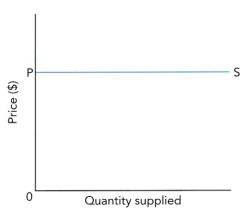
|
| (highly) elastic 富有弹性 |
>1 | 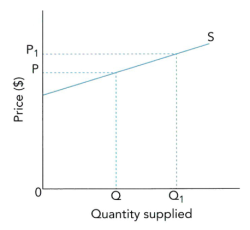
|
| unit elasticity (始终保持1的)单位弹性 |
1 | 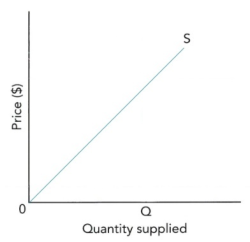
|
| (highly) inelastic 缺乏弹性 |
0~1 | 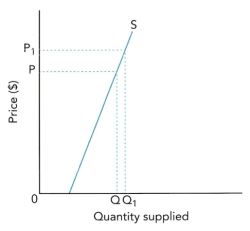
|
| perfectly inelastic 完全无弹性 |
0 | 
|
m) The factors influencing PES, including: 影响PES的因素
• factors of production
• availability of stocks
• spare capacity
• time.
- Availability of (production) substitutes生产替代品的可获得性
- 生产替代品主要指同一生产线可生产的多种产品。该商品生产线可生产的商品种类越多,该商品的PES越大。(也可以说如果生产要素更容易转换到其他产品的生产时,PES越大。)
- Availability of stocks存货/Durability耐久性(Perishable易腐烂的)
- 商品存货越多,PES越大。
- 商品越方便长时间保存,PES越大。
- Spare capacity空余产能
- 空余产能越多,PES越大。
- Time period时间
- 时间越长,PES越大。(生产要素可能无法在短期内进行转换;技术会进步)
- Barriers门槛
- 进入该行业门槛越低,PES越大。
n) Use examples to show the likely PES for manufactured and primary products. 使用例子展示制造产品与初级产品可能的PES
- manufactured products的PES相对较大(偏elastic),因为当该类商品价格上升时,企业能够较快地制造出商品并销售,供应量提升较快。反之同理。
- primary products的PES相对较小(偏inelastic),因为当该类商品价格上升时,企业不能及时获得初级商品并销售(如庄稼还需要生长一段时间),供应量提升较慢。反之同理。
1.1.4.3 Income elasticity of demand 需求的收入弹性
o) Definition of income elasticity of demand. YED的定义
- Income elasticity of demand(YED):当收入发生一定程度的变化时,需求量对收入变化的反应程度responsiveness。
p) Formula of income elasticity of demand. YED的公式
- \(YED=\frac{percentage\space change\space in\space quantity\space demanded}{percentage\space change\space in\space income}=\frac{\displaystyle{\%}\Delta Q}{\displaystyle{\%}\Delta Y}\), 其中\(\displaystyle{\%}\Delta Q=\frac{Q_{2}-Q_{1}}{Q_{1}}\), \(\displaystyle{\%}\Delta Y=\frac{Y_{2}-Y_{1}}{Y_{1}}\)
q) Calculate the income elasticity of demand using given percentage changes in quantity demanded and percentage changes in income. 计算YED
- 【参考1.1.4(q)】。
r) Interpret numerical values of income elasticity of demand that show: 解释YED的数值
• luxury goods
• normal goods
• inferior goods.
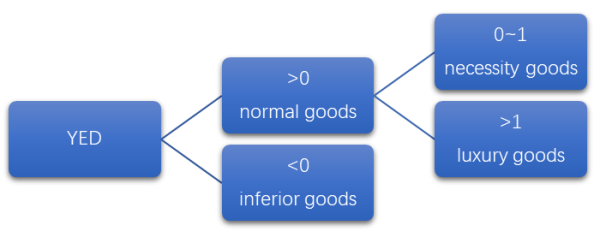
s) The significance of price and income elasticities of demand to businesses and the government, in terms of: PED和YED对企业和政府的重要性
• the imposition of indirect taxes and subsidies
• changes in income.
- 企业根据PED的情况,可以去了解:
- Price variations in a market 市场价格变动(包括因为税收或补贴带来的价格变动)
- Changing prices on consumer expenditure and sales revenue 价格变动对销售额(消费者花费)的影响,用来制定相应的盈利策略,比如是否可以通过降价促销来增加利润。
- 企业可通过persuasive advertising广告、branding建立品牌、takeovers or mergers兼并收购、monopoly垄断等手段来降低商品PED,从而达到涨价多赚Total revenue的目的。
- 因为商品是elastic而采用打折降价促销的方式可以打开市场,让消费者习惯使用该商品,从而在非打折期也来购买该商品,从而持久性增加TR。但该手段有一定风险性,因为人们会在非打折期减少该商品的消费而等待打折,竞争对手也可能会同时降价而导致降价难以达到增加TR的目的(甚至有可能因为竞争对手抢夺市场而下降)
- Effects of changes in indirect taxes on government income 间接税变化对政府收入的影响
- 企业根据YED的情况,可以:
- 初步判定目标人群,更有利于推销商品。
- 预估未来可能的需求量。(考虑到经济增长或衰退、人们的收入上升或下降,来估计消费者对产品的需求,以调整产量)
1.1.5 The mixed economy 混合经济
- 大纲要求
a) Definition of mixed economy. 混合经济的定义
- Mixed economy:计划经济。市场和政府共同决定生产计划。
- 世界上绝大多数国家都实行的是mixed economy。
- 常见的一些国家处于mixed economy中的位置:
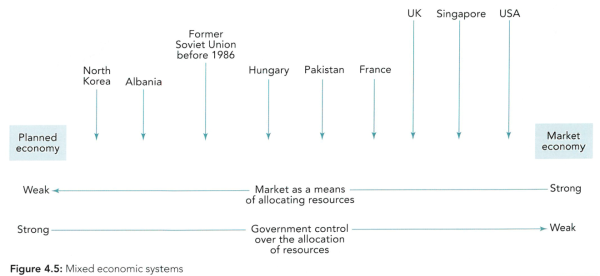
- Free market economy:自由市场经济,指仅由市场力(供求关系)确定的价格来决定资源分配的经济体制。
- Command economy:指令型经济,又称为planned economy计划经济,指仅由政府来决定资源分配的经济体制。
b) Definition of public and private sector. 公共部门与私有部门的定义
- Public sector:公共部门,一般指政府或国企。
- Private sector:私有部门,一般指私企。
c) Difference between public and private sectors in terms of ownership, control and aims. 公共部门与私有部门在所有权、控制与目标之间的区别
- 私有部门的常见类型:
- sole trader独资企业
- partnership合伙人企业
- company私有公司
- 私有部门的目标:
- Profit maximisation利润最大化
- Survival存活
- Growth成长
- Social responsibility社会责任
- 公共部门的常见类型:
- Public corporations(state-owned enterprises(SOEs))国企
- Local authority services地方当局服务(如图书馆、运动场等)
- Other public sector organisations其他公共部门机构(如邮局、铁路等)
- 公共部门的目标:
- Improving the quality of services提高服务质量
- Minimising costs成本最小化
- Allow for social costs and benefits考虑社会成本与社会收益(关注外部性)
- Profits盈利(指一些国企需要帮政府获取一部分财政收入)
d) How the problems of what to produce, how to produce and for whom to produce are solved in the mixed economy. 生产什么、怎么生产与为谁生产的问题在混合经济中如何得到解决
- 对基本经济问题的细致解释:
- What to produce生产什么(生产的种类、数量与质量)
- how to produce怎么生产(资源以何种方式使用,生产的设备、技术、人员情况)
- for whom to produce为谁生产(是否每个人都能享受到生产带来的福利,收入与财富的分配)
- mixed economy混合经济中,政府来决定经济中的大事件,市场来决定普通事项。一般情况下以市场为主,政府干预为辅,整个趋势向privatisation私有化方向发展。
- Mixed economy的优势
- 有利于经济快速增长,提升生产效率efficiency,吸引大量投资。
- 增加就业机会create jobs。
- 政府干预government intervention在一定程度上可降低市场失灵market failure带来的福利损失welfare loss。
- Mixed economy的问题
- private sectors私有部门不断削减成本,很多企业搬离发达国家去了低成本地区low-cost location,发达国家的失业情况unemployment变得严重起来。
- 贫富差距inequality逐渐拉大。
e) Concept of market failure – linked to inefficient allocation of resources. 市场失灵的定义
- Market failure:市场失灵,指free markets自由市场无法有效率地配置资源的情况。(inefficient resource allocation)
f) Why governments might need to intervene because of market failure. 为什么政府会因为市场失灵而干预经济
- externalities in the market市场存在外部性
- 市场不考虑对第三方的影响,因此实际产量与最佳产量有差异。
- Lack of competition缺少竞争(monopoly power垄断力)
- 没有竞争压力会使得企业生产效率下降,限制产量以提升价格,实际产量低于最优产量。
- Missing market没有市场
- 私有市场不提供public goods公共产品。【参考1.1.5(g)】
- Merit goods有益商品在市场中提供不足,而demerit goods有害商品在市场中提供过多。
- information failure信息失灵
- 由于缺少信息、信息错误等原因,导致人们做出了错误判断。
- Factor immobility要素的不可移动性
- 有些生产要素由于各种原因不能及时移动,导致资源配置不够合理,效率较低。
g) Definition of public goods – non-excludability, non-rivalry and how this causes the free rider problem. 公共产品的定义
- 商品可分为private goods私有商品和public goods公共产品。区分标准为是否具有excludability和rivalry两种特征。
- Excludability:排他性。该商品的拥有者可以通过某些手段阻止其他人使用该商品,如禁令、收费、许可证等。
- Rivalry:竞争性。消费者之间构成竞争关系,一个人使用该商品将减少其他人使用的可能性或数量。
- Private goods私有商品:具有excludability和rivalry两种特征。
- 大多数商品属于private goods。
- Public goods公共产品:具有non-excludability和non-rivalry两种特征。
- 举例:police force警察, national defence (national security) 国防, fire protection消防, street lights路灯, non-toll roads不收费公路, traffic lights交通灯, lighthouse灯塔, flood control systems防洪系统。
- Public goods公共产品带来的问题:free rider problem。free rider problem搭便车问题指一旦有人提供了公共产品,其他人都可以免费且完整地使用(由non-excludability和non-rival的特征导致)。因为有了该问题,私人企业无法从公共产品上盈利,因此不会提供公共产品。
- 解决私企不提供公共产品的办法:
- 政府直接提供direct provision by the government
- 政府补贴私人企业subsidies
h) The role of the public sector and private sectors in the production of goods and services. 公共部门与私有部门在产品和服务生产中的角色
- 以市场经济为主的国家,public sector公共部门一般为private sector私有部门做补充。如果私企由于种种原因(如不盈利、信息差等)没有提供或提供过多/过少的商品,则公共部门会将其调节到社会最优的产量位置上。Private sector私有部门则致力于提供大多数的商品和服务,不断增加利润、提升效率、削减成本和科技研发。
- 以计划经济为主的国家,public sector公共部门主导资源的配置和产品的生产。Private sector私有部门受到较多限制。
i) The relative importance of public sector and private sector in different economies. 公共部门和私人部门在不同经济中的相对重要性
- 【参考1.1.5(h)】。
j) Definition of privatisation. 私有化的定义
- privatisation:私有化,指企业的所有权由国家所有转为私人(或私企)所有。
- 通过私有化,公共部门中的企业逐渐转化为私有部门,能够提高生产效率,是历史大趋势。
- 私有化的途径:
- Sale of nationalised industries售卖国有企业
- Contracting out外包
- The sale of land and property卖土地和国有资产
- 私有化的原因:
- To generate income增加收入
- Public sector organisations were inefficient公共部门没有效率
- To reduce political interference减少政治干预
k) Effects of privatisation on: 私有化的影响
• consumers
• workers
• businesses
• government.
- privatisation带来的好处:
- 通过price mechanism分配资源,提升分配效率。
- 提升企业利润。
- 企业由于逐利和面对更强的竞争压力,会自发降低成本、提高效率、研发新技术,进而降低价格、增加品种、提升质量。消费者可以因此享受到低价、高质量、新版本的商品。
- 企业可能通过diversification多样化或mergers and takeovers兼并收购等方式扩大生产规模和避免倒闭。
- 为政府贡献更多税收。
- privatisation可能带来的问题:
- 无法盈利的商品将不再提供。
- 注意不可将一些战略性商品的生产权交给私企。
- 如果私企仍然属于monopoly垄断性质,效率仍然得不到提升。
- 可能会导致市场上的恶意竞争。
- 容易导致失业。
- 贫富差距可能拉大,穷人能够买到的商品减少,生活质量降低。
- 如果私企属于劳动力市场的monopsony买方垄断性质,则会剥削劳动者。
1.1.6 Externalities 外部性
- 大纲要求
1.1.6.1 External costs of production生产的外部成本
a) Definition of external costs. 外部成本的定义
- Externality:外部性。对第三方带来的收益或成本(side effects副作用)。
- Third parties:第三方。指不属于交易双方的其他经济个体。
- 外部性不在private sector私人部门的考量范围内,因此不会体现在价格中。
- external costs:外部成本,指对第三方带来的额外成本。
===b) Examples of external costs, including pollution, congestion and environmental damage. 外部成本的例子
- 常见的external costs举例:pollution污染、congestion交通拥堵、environmental damage环境危害等。
1.1.6.2 External benefits of consumption消费的外部收益
c) Definition of external benefits. 外部收益的定义
- external benefits:外部收益,指对第三方带来的额外收益。
d) Examples of external benefits, including education, healthcare and vaccinations. 外部收益的例子
- 常见的external benefits举例:education教育、healthcare医疗、vaccinations疫苗等。
e) Definition and formula for: 社会成本与社会收益的定义与公式
{{{2}}}
- Social benefits社会收益指的是社会所有群体的收益,包括交易双方的收益(Private benefits私有收益)与对第三方(其他人)的收益(External benefits外部收益)。
- Social benefits是政府考量的,而Private benefits是私人部门考量的。
- Social benefits (SB) = Private benefits (PB) + External benefits (EB)
- Social costs社会成本指的是社会所有群体的成本,包括交易双方的成本(Private costs私有成本)与对第三方(其他人)的成本(External costs外部成本)。
- Social costs是政府考量的,而Private costs是私人部门考量的。
- Social costs (SC) = Private costs (PC) + External costs (EC)
